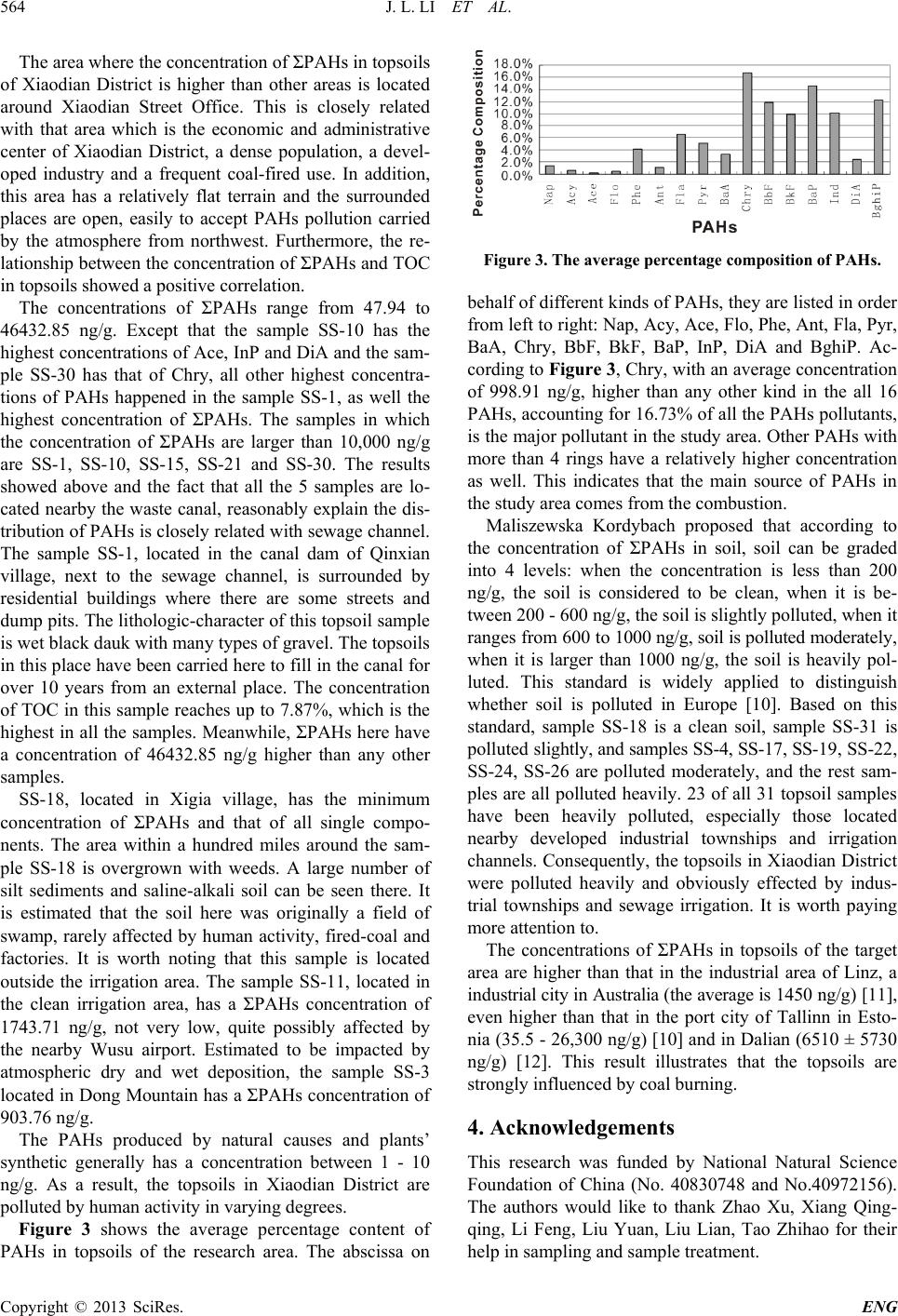
J. L. LI ET AL.
Copyright © 2013 SciRes. ENG
The ar ea w here th e con c ent rat io n of ΣPAHs in topsoils
of Xiaodian District is higher than other areas is located
around Xiaodian Street Office. This is closely related
with that area which is the economic and administrative
center of Xiaodian District, a dense population, a devel-
oped industry and a frequent coal-fired use. In addition,
this area has a relatively flat terrain and the surrounded
places are open, easily to accept PAHs pollution carried
by the atmosphere from northwest. Furthermore, the re-
lationship between the concentration of ΣPAHs and TOC
in topsoils showed a positive correlation.
The concentrations of ΣPAHs range from 47.94 to
46432.85 ng/g. Except that the sample SS-10 has the
highest concentrations of Ace, InP and DiA and the sam-
ple SS-30 has that of Chry, all other highest concentra-
tions of PAHs happened in the sample SS-1, as well the
highest concentration of ΣPAHs. The samples in which
the concentration of ΣPAHs are larger than 10,000 ng/g
are SS-1, SS-10, SS-15, SS-21 and SS-30. The results
showed above and the fact that all the 5 samples are lo-
cated nearby the waste canal, reasonably explain the dis-
tribution of PAHs is closely related with sewage channel.
The sample SS-1, located in the canal dam of Qinxian
village, next to the sewage channel, is surrounded by
residential buildings where there are some streets and
dump pits. The lithologic-character of this topsoil sample
is wet black dauk with many types of gravel. The topsoils
in this place have been carried here to fill in the canal for
over 10 years from an external place. The concentration
of TOC in this sample reaches up to 7.87%, which is the
highest in all the samples. Mean while, ΣPAHs here have
a concentration of 46432.85 ng/g higher than any other
samples.
SS-18, located in Xigia village, has the minimum
concentration of ΣPAHs and that of all single compo-
nents. The area within a hundred miles around the sam-
ple SS-18 is overgrown with weeds. A large number of
silt sediments and saline-alkali soil can be seen there. It
is estimated that the soil here was originally a field of
swamp, rarely affected by human activity, fired-coal and
factories. It is worth noting that this sample is located
outside the irrigation area. The sample SS-11, located in
the clean irrigation area, has a ΣPAHs concentration of
1743.71 ng/g, not very low, quite possibly affected by
the nearby Wusu airport. Estimated to be impacted by
atmospheric dry and wet deposition, the sample SS-3
located in Dong Mountain has a ΣPAHs concentration o f
903.76 ng/g.
The PAHs produced by natural causes and plants’
synthetic generally has a concentration between 1 - 10
ng/g. As a result, the topsoils in Xiaodian District are
polluted by human activity in varying degrees.
Figure 3 shows the average percentage content of
PAHs in topsoils of the research area. The abscissa on
Figure 3. The average percentage composition of PAHs.
behalf of different kinds of PAHs, they are listed in order
from left to right: Nap, Acy, Ace, Flo, Phe, Ant, Fla, Pyr,
BaA, Chry, BbF, BkF, BaP, InP, DiA and BghiP. Ac-
cording to Figure 3, Chry, with an average concentration
of 998.91 ng/g, higher than any other kind in the all 16
PAHs, accountin g for 16.73% of all the PAH s pollutants,
is the major pollutant in the study area. Other PAHs with
more than 4 rings have a relatively higher concentration
as well. This indicates that the main source of PAHs in
the study area comes from the combustion.
Maliszewska Kordybach proposed that according to
the concentration of ΣPAHs in soil, soil can be graded
into 4 levels: when the concentration is less than 200
ng/g, the soil is considered to be clean, when it is be-
tween 200 - 600 ng/g, the soil is slightly polluted, when it
ranges from 600 to 1000 ng/g, soil is polluted moderately,
when it is larger than 1000 ng/g, the soil is heavily pol-
luted. This standard is widely applied to distinguish
whether soil is polluted in Europe [10]. Based on this
standard, sample SS-18 is a clean soil, sample SS-31 is
polluted slightly, and samples SS-4, SS-17, SS-19, SS-22,
SS-24, SS-26 are polluted moderately, and the rest sam-
ples are all polluted heavily. 23 of all 31 topsoil samples
have been heavily polluted, especially those located
nearby developed industrial townships and irrigation
channels. Consequently, the topsoils in Xiaodian District
were polluted heavily and obviously effected by indus-
trial townships and sewage irrigation. It is worth paying
more attention to.
The concentrations of ΣPAHs in topsoils of the target
area are higher than that in the industrial area of Linz, a
industrial city in Au stralia (the averag e is 1450 ng/g) [11],
even higher than that in the port city of Tallinn in Esto-
nia (35.5 - 26,300 ng/g) [10] and in Dalian (6510 ± 5730
ng/g) [12]. This result illustrates that the topsoils are
strongly influenced by coal burning.
4. Acknowledgements
This research was funded by National Natural Science
Foundation of China (No. 40830748 and No.40972156).
The authors would like to thank Zhao Xu, Xiang Qing-
qing, Li Feng, Liu Yuan, Liu Lian, Tao Zhihao for their
help in sampling and sample treatment.